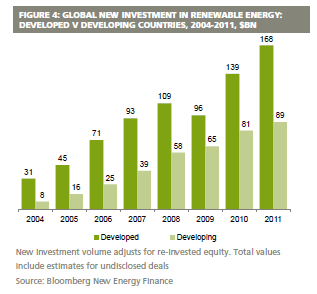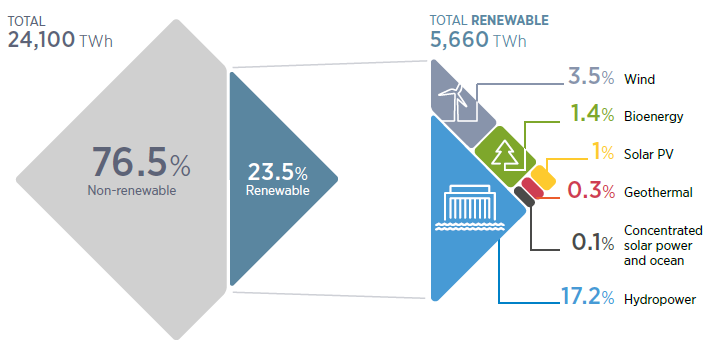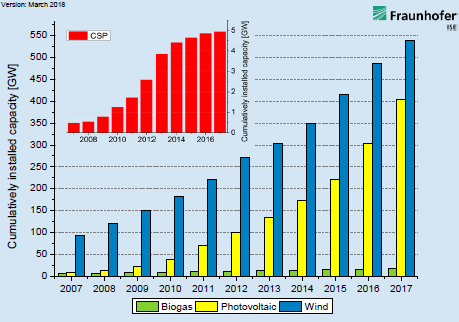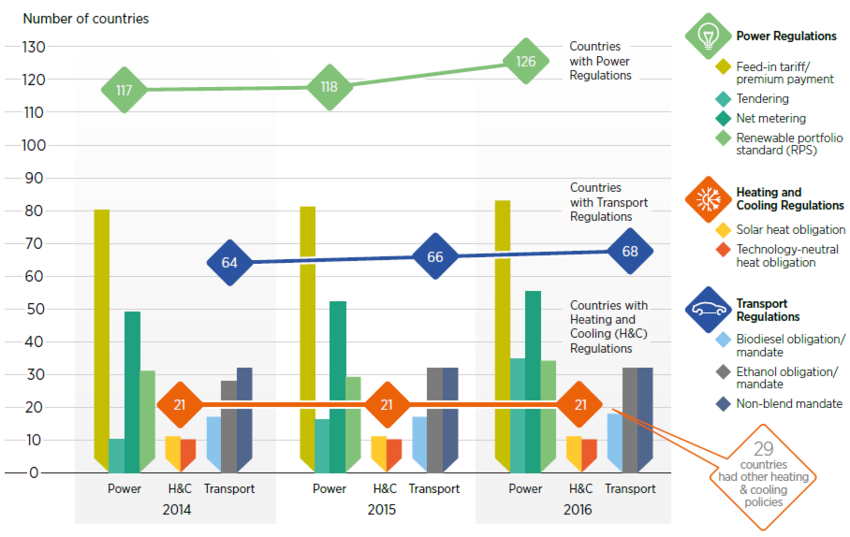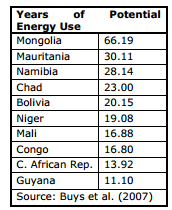Difference between revisions of "The Economics of Renewable Energy"
***** (***** | *****) |
***** (***** | *****) m |
||
| Line 31: | Line 31: | ||
<br/> | <br/> | ||
| − | |||
== Challenges to Consider == | == Challenges to Consider == | ||
| Line 46: | Line 45: | ||
<br/> | <br/> | ||
| − | |||
= Rationale for <span data-scayt_word="renewables" data-scaytid="4">Renewables</span><br/> = | = Rationale for <span data-scayt_word="renewables" data-scaytid="4">Renewables</span><br/> = | ||
| Line 179: | Line 177: | ||
<br/> | <br/> | ||
| + | <br/> | ||
= Market Competition - Renewables V.s. Fossil Fuels = | = Market Competition - Renewables V.s. Fossil Fuels = | ||
| Line 291: | Line 290: | ||
<br/> | <br/> | ||
| + | <br/> | ||
= <span style="line-height: 30px; font-size: 22px;">Increasing the Use of Renewable Energy</span><br/> = | = <span style="line-height: 30px; font-size: 22px;">Increasing the Use of Renewable Energy</span><br/> = | ||
| Line 325: | Line 325: | ||
= References = | = References = | ||
| − | <references /> & | + | <references /> |
[[Category:Biomass]] | [[Category:Biomass]] | ||
Revision as of 11:47, 18 September 2018
► Back to Financing & Funding Portal
Overview
In order to assess how private investment in renewables can be increased, it is necessary to understand the economics of renewable energy.
The Energy Transition-Economic Development Correlation
The histories of energy transitions, development of economies and industrial civilizations, all go hand in hand[1][2]. Going back in time, people only needed to cover their basic needs, such as food, which was met by practicing agriculture in the first formed human communities, essentially depending on the sun for such practices[1][2]. A step ahead, solar energy was used as a stored form in firewood and biomass (Mainly animal dung) energy to supply for cooking and heating human needs[1][2].
As economies evolved and developed a complex forms, with the human needs surpassing the basic ones, the energy needs consequently had to increase to meet such demand, hence dependence on firewood and biomass proved to be insufficient to meet that new rise in demands, so people started turning into hydropower, then to coal during the 19th century, oil and natural gas in the 20th, in addition to nuclear that was introduced in mid-20th century as well[1][2].
Therefore, it is apprehendable that each critical change in the economic system, or each economic development along history was always accompanied with a major energy transition -and vice versa-, shifting from one major energy source to another[1][2]. Currently, while fossil fuels (coal, oil and natural gas) are the dominant energy sources, the transition is already taking place from these sources into renewables (solar, wind, hydro... etc.)[1][2].
Though, the 21st century energy transition is going underway, not mainly because of change in human needs, but due to few main factors[1][2]:
- Concerns about environmental impacts (Degradation, GHG, Climate Change… etc.)
- The ongoing depletion of current energy sources, as they are limited and on the decline (Millions of years to form, decades or less to consume)
- Prices and technological change
Considering the added costs to mitigate, adapt or fight the environmental side effects of the usage of fossil fuels as main energy source, renewables might be the only option that people/societies/governments have to adopt, in order to reform the current economic system –at least in the energy sector- into a new one.
Challenges to Consider
Assuming that renewable energy sources will actually be able to take hold in the near future, then few questions need to be argued and discussed beforehand: What renewable energy sources are available? How optimization of renewable energy mix will be determined? How will optimum mixtures of renewable-energy sources differ based on location? How to determine and calculate the direct and external costs of renewable energy sources? How will the existed achievements of renewable-energy sector affect the way energy is processes in current economy? What kind of changes in sectors of engineering, economy and policy would be needed to adapt to renewable energy sources?[2]
Scale is also an important issue. This is due to the fact that fossil-fuel technologies have been developed, improved and manufactured on an increasing scale for a century. This is not yet the case for renewables[3].
Economically, futuristic projections of energy sources’ prices and their technologies are vital for forecasting the economic options of the energy supply, also with few critical questions in mind: Should the choice of a technology be based on its current market price or because of its potential future cost reductions? Which technologies offer the most effective outcomes for specific applications? If the current technology is too expensive, should governmental subsidies help to achieve cost reduction for economic viability or is it better to wait for market forces –Smith’s invisible hands- to do the job?[4]
Rationale for Renewables
Worldwide, more energy is required to enable economic development. Fossil fuels are a finite resource that contribute to climate change and cause other problems like smog, extended supply lines and vulnerable power grids.
Utilizing renewables would help to avoid these problems, create new job opportunities and reduce the drain on hard currency for poorer countries. Because conventional fuels have received long-term subsidies in the past, it is vital that governments support the development of renewables in the form of financial incentives that can create a level playing field [5].
Few further reasons which have contributed in the acceleration of both public and private investment in renewable energy[2][6]:
- The growing demand for energy, which consequently requires a certain economic development.
- The current critical environmental and climatic conditions, which drive the need to redirect energy technologies into more diverse, environmentally sustainable supply sources.
- The need to ensure futrue energy security.
- Mostly for developing countries in particular: Rapid urbanization, economic growth, uprising demographic trends and severe climate change conditions.
The future of the renewables industry depends on finance, risk-return profiles, business models, investment lifetimes and a host of other economic, policy and social factors. Many new sources of finance are possible such as insurance funds, pension funds and sovereign wealth funds along with new mechanisms for financial risk mitigation. Many new business models are also possible for local energy services, utility services, transport, community and cooperative ownership, and rural energy services [7].
In 2011, the global investment in renewable power and fuels increased by 17% to a new record of $257 billion dollars. Significantly, developing economies made up 35% of this total investment [8].
Renewable energy technologies (RETs) continue to face a number of barriers. But since the technology is currently existent for implementing renewable energy sources, and on the rise, hence, the major challenge is mainly economic, as the issue of renewable energy technologies' costs is vital and central for the prediction of how rapidly the current energy transition will be taking place, noting that the costs include: infrastructure investment, day-to-day operations, market costs of supply and the environmental costs of the different energy sources[2][6].
Therefore, the debate remains mainly focused on the economic and financial perspectives, particularly on the cost-effectiveness of renewable energy technologies, and the possible various economic incentives to promote renewables globally in terms of: regulatory design and affordability[6].
Economic Rationale of Renewables
While by 2014 the world was getting about 80% of its energy supplies from fossil fuels[2], that percentage has gone down 3.5-4% only within 3-4 years, as the global energy supply of fossil fuels by 2017/18 has reached around approximately 76.5%[6][9].
The cost advantage that fossil fuels used to have over renewable energy sources has been decreasing recently, and few renewable technologies are already competing fossil fuels directly on the financial frontier, furthermore, renewables' costs are expected to decline even further, and those of fossil fuels will incline, mainly because the economic development factors are moving towards that direction[2].
The renewables' market development during the past few 10-15 years had few moving factors, which can be summarized in the following:
- As the Kyoto Protocol, in early 2005, entering into force, one outcome was the exponential growth of global investment in renewables[6].
- The rapid growth in energy demand for emerging economies, such as the cases of China & India, which are driven by transforming their energy industries[6][10].
- The uprising competition for energy sources[6].
- Inclining geopolitical tension[6].
- Energy security concerns[6].
- Increasing prices of oil and gas[6].
- The technological developments in the renewables' sector, and the emergence of more technology applications, especially generation of solar photovoltaic and wind power, which actually alone make renewables more competitive, even without investment support[11][12].
- The modern need to commit to a long-term sustainable energy targets has further impoved the climate for investments in renewables[12].
- The positive support of polciy and law-makers in various countries, ensuring the scarcity and on-the-rise prices of fossil fuels and climate challenges[12].
- The intensive research efforts, leading to improved system solutions with much higher efficiencies and lower production and operation costs[12].
Costs of Renewables
Costs of Fossil Fuels
Costs relative to fossil fuels are also important particularly because:
1. Fossil-fuel energy does not reflect its full social costs.
- Climate change has been described as the "biggest market failure in history" (Stern Review, 2006) because the environmental costs associated with carbon emissions are not included in market prices.
- Furthermore, fossil fuels are subsidized for about US$300 billion per year. Removing theses subsidies and incorporating externalities into fossil fuel costs would dramatically change relative costs[3].
2. It is more expensive to deliver non-renewable energy in some places than others.
- For example, rural communities in developing countries are often not connected to the grid, resulting in "off-grid" energy production - particularly solar power - being more competitive[3].
3. Fossil Fuels are fast depleting and more scarce than RE (See figure below).
- In terms of primary energy, it is already technically possible to generate many multiples of global energy supply using solar energy. There is also an abundant supply of wind or geothermal power to meet all of today’s global electricity demand[3].
The International Energy Agency's (IEA) Renewable Energy Technology Deployment Group reports that generation costs for renewable power are also falling and approaching the costs for gas and coal fired plants, especially when the hidden subsidies that thermal generation plants receive is taken out of the equation.
On the other hand, the cost of gas and coal fired plants is increasing because they are being used less, largely due to policy support for renewables construction delays, higher financing rates, and the increasing cost of fuel in some European countries and in Japan.
Crucially, the higher capital costs involved in some new-build thermal plants due to emission reduction systems will be positively or negatively influenced by the shape and provisions of future policies for emission control[13].
Significantly, much of the global solar power potential is concentrated in developing countries, although other areas also have a high potential.
The table below shows the top 10 countries globally in terms of renewable energy potential relative to energy use. They are all developing countries, which reflects their relatively low energy use at present, but also the relative abundance of solar, wind, hydro and geothermal energy [3]. It's clear that there is significant scope to increase the use of renewable energy in developing countries.
Currently most solar power installed globally is available in Europe, which accounts for more than 70% of the world's new PV installations[14].
Market Competition - Renewables V.s. Fossil Fuels
As the markets develop, the costs normally do as well, as both developments go hand in hand[4][2]. As the previously mentioned factors push the market to increase its renewables' volume, that leads to economies of scale, consequently reducing the price and later the actual costs of the tehcnology, and on the other hand, reduced prices increase market volumes, again producing economies of scale, eventually resulting in a feedback loop leading either way to the overcoming of renewables[4][15].
The continuous pressure on market prices and its margins is rapidly forcing the market to change, which is already the current situation, as renewables' costs have considerably declined and still on the decline, since their costs are expected to go down even further over the coming few years[9][4]. Furthermore, adding to renewables' economic evolution, both public commitments and the maturing technologies, investments in renewables have rapidly increased turning the renewables industry to a very competitive sector against other energy resources, noting that the competition is not only limited within the energy or power sector itself, but diffrenet renewables are even starting to compete against each other withing the renewables' sector itself[9][4].
| Technology | Market & Costs' Development | Years | Why? | Futuristic Expectations |
|---|---|---|---|---|
| Solar PV |
|
|
|
|
| Wind Power |
|
|
|
|
| Concentrated Solar Power (CSP) & Solar Thermal Energy (STE) |
|
|||
| Hydropower |
|
|
|
|
| Biomass Power |
|
|
With costs of renewables are continuing to fall, drastically in solar PV, followed by wind and concentrated solar power closely behind, the global installed capacity has exponentially grown, as a world record amount of recently installed renewables' (espicially solar PV, wind, CSP & hydro) capacity has been added in the past few years, adding up to almost two thirds of the all new generating capacity installed globally in 2016[9][4].
Renewables' power capacity investments have by far surpassed those of fossil fuels in the year 2017, and emerging countries overcame industrialized ones in that sector, thus being catalyzed by increasing innovation, competition and policy support in such countries, achieving radical technological advances and sharp cost reduction in renewables' sector, pushing them to outpace any other technology source[9].
Increasing the Use of Renewable Energy
There is significant scope to increase the use of renewables especially in developing countries. However, this potential is not limitless. Although it can be expected that the costs of renewables will continue to fall relative to fossil fuels, (especially in countries with high renewable energy potential), fossil fuels will probably retain a cost advantage[3].
The IEA in a recent report concluded that there is no unique costs of renewable or non-renewable power generation. Cost ranges associated with any power generation are relatively large and highly dependent on the regulatory and market contexts.
The report stressed the necessity of maintaining current incentives in order to provide business cases that can interest investors as generally the costs of both new renewable power plants and new-non-renewable generation are higher than the market price of electricity.
Expansion of Renewable Energy Use:
- The basic economics of renewable energy need to be artificially altered, either by increasing the cost of fossil fuel-based energy (e.g. through taxes or equivalent mechanisms), or by reducing the costs of renewable energy (e.g. subsidies), or by boosting the returns to renewable energies (e.g. through paying a premium for this form of energy) [3].
- Developing countries should not necessarily be required to meet these costs. This is particularly so where the development of renewable energy capacity may place countries at a competitive disadvantage and/or these countries bear no responsibility for climate change. The costs should be met by countries that do bear these responsibilities. This case is even stronger while developed countries are subsidizing fossil-fuel energy[3].
Further Information
- Assessing the Economic Viability of Business Ideas for Productive Use
- Economic and Financial Impacts of Grid Interconnections
- Economic Viability of a Biogas Plant
- Economic Analyses of Wind Energy Projects
- Macro-economic evaluation of Biogas Plants
- Socio-economic and Environmental Impacts of MHP
- Subsidies
References
- ↑ 1.0 1.1 1.2 1.3 1.4 1.5 1.6 Bridge, G. Bouzarovski, S. Bradshaw, M. & Eyre, N. (2013). Geographies of energy transition: space, place and the low-carbon economy. Energy Policy 53: 331-340. URL: http://www.sciencedirect.com/science/article/pii/S0301421512009512
- ↑ 2.00 2.01 2.02 2.03 2.04 2.05 2.06 2.07 2.08 2.09 2.10 2.11 2.12 Timmons, D. Harris, J. M. & Roach, B. (2014). The Economics of Renewable Energy. Retrieved From: https://ase.tufts.edu/gdae/education_materials/modules/RenewableEnergyEcon.pdf
- ↑ 3.0 3.1 3.2 3.3 3.4 3.5 3.6 3.7 Griffith-Jones, S., Ocampo, J. A. & Spratt, S., 2011. Financing Renewable Energy in Developing Countries: Mechanisms and Responsibilities. Available at: http://erd-report.eu/erd/report_2011/documents/dev-11-001-11researchpapers_griffith-jones-ocampo-spratt.pdf Cite error: Invalid
<ref>tag; name "Griffith-Jones, S., Ocampo, J. A. & Spratt, S., 2011. Financing Renewable Energy in Developing Countries: Mechanisms and Responsibilities. Available at: http://erd-report.eu/erd/report_2011/documents/dev-11-001-11researchpapers_griffith-jones-ocampo-spratt.pdf" defined multiple times with different content - ↑ 4.0 4.1 4.2 4.3 4.4 4.5 4.6 REN21. (2017). Renewables Global Futures Report: Great Debates towards 100% Renewable Energy. Retrieved From: http://www.ren21.net/wp-content/uploads/2017/10/GFR-Full-Report-2017_webversion_3.pdf
- ↑ United Nations Environment Programme Finance Initiative (UNEP FI), 2004. CEO briefing - Renewable Energy, Geneva, Switzerland: United Nations Environment Programme Finance Initiative (UNEP FI).
- ↑ 6.0 6.1 6.2 6.3 6.4 6.5 6.6 6.7 6.8 6.9 Meier, P. Vagliasindi, M. Imran, M. Eberhard, A. & Siyambalapitiya, T. (2015). The Design and Sustainability of Renewable Energy Incentives: An Economic Analysis. Retrieved From: https://openknowledge.worldbank.org/bitstream/handle/10986/20524/922240PUB0978100Box385358B00PUBLIC0.pdf?sequence=1
- ↑ Appleyard, D., March 2013. The Future of Renewables: Economic, Policy and Social Impications - Renewable Energy World International. Available at: http://www.renewableenergyworld.com/rea/news/article/2013/03/from-the-editor20
- ↑ Frankfurt School UNEP Collaborating Centre for Climate & Sustainable Energy Finance, 2012. Global Trends in Renewable Energy Investment 2012, Frankfurt am Main, Germany: Frankfurt School UNEP Collaborating Centre for Climate & Sustainable Energy Finance.
- ↑ 9.0 9.1 9.2 9.3 9.4 International Renewable Energy Agency (IRENA). International Energy Agency (IEA). & Renewable Energy Policy Network for the 21st Century (REN21). (2018). Renewable Energy Policies in a Time of Transition. Retrieved From: http://www.ren21.net/wp-content/uploads/2018/04/17-8622_Policy_FullReport_web_.pdf
- ↑ International Renewable Energy Agency (IRENA), International Energy Agency (IEA) & Renewable Energy Policy Network for the 21st Century (REN21). (2018). Renewable Energy Policies in a Time of Transition. Retrieved From: http://www.irena.org/-/media/Files/IRENA/Agency/Publication/2018/Apr/IRENA_IEA_REN21_Policies_2018.pdf
- ↑ Yamamoto, Y. (2018). Feed-in Tariffs and the Economics of Renewable Energy. Retrieved From: https://www.springer.com/de/book/9783319768632
- ↑ 12.0 12.1 12.2 12.3 12.4 Fraunhofer ISE. (2018). Levelized Cost of Electricity Renewable Energy Technologies. Retrieved From: https://www.ise.fraunhofer.de/content/dam/ise/en/documents/publications/studies/EN2018_Fraunhofer-ISE_LCOE_Renewable_Energy_Technologies.pdf
- ↑ Bayar, T., 2013. The Cost of New Renewable Power Generation: Approaching Parity? Available at: http://www.renewableenergyworld.com/rea/news/article/2013/07/costing-renewable-power-generation?cmpid=rss
- ↑ EPIA. Global Market Outlook for Photovoltaics 2013-2017. http://www.epia.org/news/publications/global-market-outlook-for-photovoltaics-2013-2017/
- ↑ 15.0 15.1 International Renewable Energy Agency (IRENA). (2017). Renewable Power Generation Costs in 2017. Retrieve From: https://www.irena.org/-/media/Files/IRENA/Agency/Publication/2018/Jan/IRENA_2017_Power_Costs_2018.pdf

